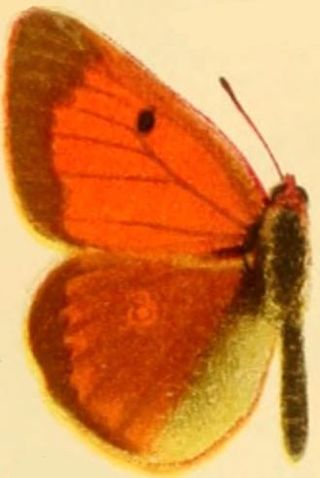
The Pieridae are a large family of butterflies with about 76 genera containing about 1,100 species, mostly from tropical Africa and tropical Asia with some varieties in the more northern regions of North America and Eurasia. Most pierid butterflies are white, yellow, or orange in coloration, often with black spots. The pigments that give the distinct coloring to these butterflies are derived from waste products in the body and are a characteristic of this family. The family was created by William John Swainson in 1820.

The blood pheasant or blood partridge is a galliforme bird in the pheasant family Phasianidae and the only species in the genus Ithaginis. It is a relatively small, short-tailed pheasant that is widespread in the lower Himalayas ranging across North and East India, Nepal, Bhutan, South China and northern Myanmar. It has been classified as Least Concern on the IUCN Red List since 2009, and the global blood pheasant population is thought to be stable.

Pieris, the whites or garden whites, is a widespread, now almost cosmopolitan, genus of butterflies of the family Pieridae. The highest species diversity is in the Palearctic, with a higher diversity in Europe and eastern North America than the similar and closely related Pontia. The females of many Pieris butterflies are UV reflecting, while the male wings are strongly UV absorbing due to pigments in the scales.

Papilio machaon, the Old World swallowtail, is a butterfly of the family Papilionidae. The butterfly is also known as the common yellow swallowtail or simply the swallowtail. It is the type species of the genus Papilio. This widespread species is found in much of the Palearctic and in North America.

Euchloe ausonia, the eastern dappled white, is a southern European and Palearctic butterfly found mostly to the south and east of its almost indistinguishable relative the western dappled white.

Cepora nerissa, the common gull, is a small to medium-sized butterfly of the family Pieridae, that is, the yellows and whites, which is native to Sri Lanka, India, China, southeast Asia, and Indonesia.

Byasa polyeuctes, the common windmill, is the most common member in India of the windmills genus (Byasa), comprising tailed black swallowtail butterflies with white spots and red submarginal crescents.

Parnassius acdestis is a high-altitude butterfly found in India. It is a member of the genus Parnassius of the swallowtail family, Papilionidae. The species was first described by Grigory Grum-Grshimailo in 1891.

Parnassius imperator is a high-altitude butterfly which is found in western China and north-east India. It is a member of the generally white, high-elevation genus Parnassius, known as snow Apollos, of the family Papilionidae, known as swallowtails.

Eurema andersonii, the one-spot grass yellow or Anderson's grass yellow, is a small butterfly of the family Pieridae, that is, the yellows and whites, which is found in India, Myanmar and other parts of Asia.

The Himalayan wolf is a canine of debated taxonomy. It is distinguished by its genetic markers, with mitochondrial DNA indicating that it is genetically basal to the Holarctic grey wolf, genetically the same wolf as the Tibetan and Mongolian wolf, and has an association with the African wolf. No striking morphological differences are seen between the wolves from the Himalayas and those from Tibet. The Himalayan wolf lineage can be found living in Ladakh in the Himalayas, the Tibetan Plateau, and the mountains of Central Asia predominantly above 4,000 m (13,000 ft) in elevation because it has adapted to a low-oxygen environment, compared with other wolves that are found only at lower elevations.
Harish (Honnayya) S. Gaonkar is an Indian specialist on butterflies who contributed to the Zoological Museum at the University of Copenhagen, Denmark and wrote a 1996 compilation of butterflies of Western Ghats, South India cataloguing 330 species. Gaonkar earned his PhD from the University of California, Berkeley.

Colias heos is a butterfly in the family Pieridae. It is found in the East Palearctic.

Colias montium is a butterfly in the family Pieridae. It is found in the eastern Palearctic realm.

Colias nebulosa is a butterfly in the family Pieridae. It is found in the eastern Palearctic realm.
Sinopieris dubernardi, or Oberthür's white, is a species of butterfly in the family Pieridae. It is treated as a member of the genus Sinopieris, or alternately, the genus Pontia. It is found in China, where it inhabits grassland plateaus and mountainsides at elevations above 2,000 meters.

The Turkestan lynx, also known as the Central Asian, Tibetan or Himalayan lynx, is a subspecies of the Eurasian lynx distributed in Central Asia and in the Himalayas.















